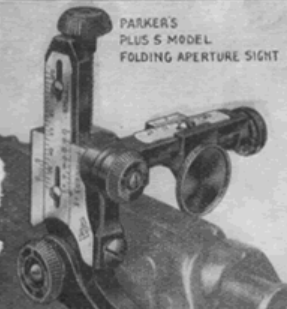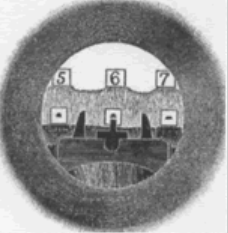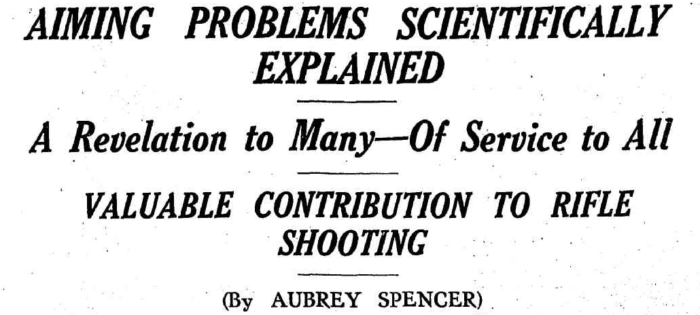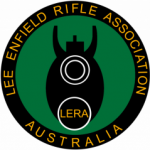Medical Man Co-ordinates Eye and Aperture Requirements A Revelation to Many — Of Service to All
VALUABLE CONTRIBUTION TO RIFLE SHOOTING (By AUBREY SPENCER)
This week’s article from the pen of Dr. A. W. L. Row (Toowoomba, Qld.), will’ be of intense interest and helpful service to riflemen and gun-shooters generally. Its subject matter touches upon the scientific in concise, simple and explicit terms, which will be a revelation to many who have failed to solve aiming problems, or to appreciate reasons why they exist. Added interest and authority are given to the article because Dr. Row is himself a marksman of no mean ability, who has devoted considerable time and study to the finer points of rifle shooting. His opinions are removed from the field of theory to the realm of practical experience. That he has generously made the result of his studies available to riflemen through the columns of ‘The Referee’ enrolls him as a member of that large body of prominent citizens who devote so much of their valuable time in promoting the interests of the Australian rifle club movement, without any reward beyond the satisfaction of watching it grow as an element of national Defence, and the development of a sporting spirit among its followers which goes to mould national character.
Aperture numbers express the diameter of the hole in hundredths of an inch. Thus a No. 3 aperture is 3/100th inch in diameter, a No. 6 is 6/100th, and so on. Now, the light transmitted by any aperture is proportional to the tetter’s area, and hence will.be proportional to the square of its aperture number, e.g. a No. 6 aperture will transmit four times as much light as a No. 3, and so on. The pupil of an average eye, while shooting in a good light, is about 1/8inch in diameter, whereas a No. 6 aperture is about 1/17 inch in diameter, hence the No. 6 transmits only about one quarter of the light that the pupil would by direct vision; consequently, the aiming mark, when viewed through this aperture, looks only a quarter as bright as when viewed by direct vision. This, however, is only true when the keenness of vision remains the same in each case; in practice, however, by shading the eyes from the general glare, their keenness (or visual acuity) can be greatly increased by a physiological process called adaptation, and this increase in acuity will compensate in part at least for the loss of brightness due to using. an aperture smaller than, the eye’s aperture, i.e., its pupil.

SIZE OF APERTURE
The size of aperture needed for any particular light will depend not only upon the brightness of the aiming mark, but also upon the marksman’s keenness of vision (which in turn will depend upon the degree of ‘adaptation’ of his eyes as well as upon his natural acuity of vision), and also, very decidedly, upon the distance of his eye from the aperture; again, the less light there is reflected from the blackened disc of his aperture, the brighter will appear the aiming mark as seen through the aperture hence the importance .of shading the backsight as completely as possible, as well as keeping it as dead black as possible; a deep cup aids in this shading. Similarly, the eyes should lie shaded from the glare, especially the left eye, which has to be kept open during aiming to avoid eyestrain, and which has no backsight In front of it to shade it; the brim of the hat can be pulled down in front of the, left eye far enough to hide the aiming mark from it, and to cut off most of the, light from it when the head is down in the aiming position.
MINIMUM DISTANCE
Now a minimum distance between eye and aperture can safely only be secured If the recoil is perfectly controlled by uniformly accurate holding; otherwise a severe blow by the sight on cheek or nose may result. Also, a man with a short thick neck and wide shoulders will need either a shorter butt or a rearward extension on the sight to bring the aperture back closer to his eye, to avoid an uncomfortable craning forward of his neck.
FUNDAMENTAL ESSENTIALS
The fundamental essentials in aiming accurately with a rifle consist in seeing the aiming mark sufficiently brightly and the foresight absolutely sharply defined and through the centre of the aperture. As regards brightness of aiming mark, a very common mistake is to use too small an aperture, with the Idea that it allows of greater accuracy In centring the foresight; actually, what little is gained in easier centring of the foresight in the aperture is more than counterbalanced by the loss of brightness in the aiming mark, which leads the marksman to focus his eye on the aiming mark in a futile endeavor to see it more brightly, whereas he should be focusing on the foresight, as explained below Now, no eye (or any other lens system) can possibly, see equally clearly at the same moment both foresight arid distant aiming mark. To do so, in fact, would need a smallness of aperture, which is optically impossible, e.g. 1/300 inch in diameter, a hole too small to see through.
DECIDED BY TRIAL
Hence it must be decided by trial, which is the more important to see critically sharp at the moment of firing, the foresight or the aiming mark. By experience the answer has been found to be the foresight, under all conditions. With a blurred foresight and sharply focused aiming mark at the moment of firing it is very easy to get a low magpie or even an outer, whereas with a sharply focused foresight and blurred aiming mark one should seldom get even a bad inner (presuming in each case that the act of firing has not been allowed to alter the aim).

Consequently, it is vitally important to be sure that, at the moment of firing, one is seeing the foresight’s top edge and sides very sharply defined, i.e., that the eye is focused upon the foresight. This will always make the aiming mark appear slightly blurred n outline; also, the larger the aperture used the greater this blurring will be, but it does not matter so long as the foresight looks critically sharp, and is in the centre of the aperture, and is held up correctly to the aiming mark.
(A further article by Dr. Row will appear in next week’s issue, and will be a continuation of the subject dealt with above.)

